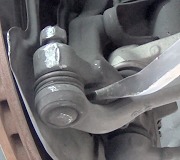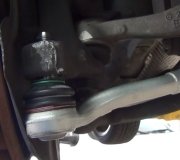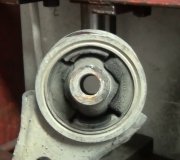Ball joints make a clunking noise long before they get so bad that they separate. When those noises are ignored and one does fall apart, the spindle and tire fall backward and hit the fender. Most of the time the sidewall gets cut and the blowout happens right there.
I have been a suspension and alignment specialist for over thirty five years, and in that time, I have only observed one new ball joint fail due to improper installation procedures. It was due to haste and carelessness, not lack of knowledge. Two years later I started working at that dealership and got to know that mechanic. He was very conscientious and experienced.
The point is, if you have the new tire installed at a different shop, tell them the recent repair history so they look closer during their inspection. If they find nothing wrong, suspect the damage to the tire was caused by the original failure. Most of the time the hole will be on the inner sidewall. Too often the mechanic was accused numerous times of trying to sell unneeded parts. Now he would rather avoid those accusations when he should have warned you to replace the tire right away. You probably would not have believed him either, just like most people. You are likely paying the price for all the previous customers who did not understand why we recommend parts you do not think are needed.
Worn brakes will not affect the tire. That is something else that should not be ignored. Also, for people researching this topic, the noises caused by ball joints take on a whole new meaning for owners of Ford products. They have some very unusual designs that have real high failure rates, and often only make noise for a few hundred miles before they separate, leading to loss of control, and a crash. Any time you hear a creak or clunk on a Ford, drive straight to a tire and alignment shop for an inspection of the steering and suspension systems. Many shops do that for free, or at no charge if they do the repairs. For all other brands of cars, when you hear those noises, it is usually safe to say you have some time to get to the shop, but definitely do not ignore the problem. When I worked for a mass merchandiser, we got over one hundred ball joints and tie rod ends shipped in every Wednesday for Ford products, and by Saturday we had to order more from the local auto parts stores. We also received about thirty parts for all other car brands combined, and we never ran out of those. My friend who worked at the local Ford dealership spent eight hours per day repairing steering and suspension systems on vehicles that were typically less than five years old, and at least once or twice per week, a car or pickup truck came in on the tow truck with the same failure you experienced. Any one of those could have caused the vehicle to come skidding across the road into my vehicle.
As an additional wondrous comment of value, if a mechanic brings you into the shop to show you the unacceptable movement in a worn ball joint, there should be no movement up and down or sideways. Sideways movement is never acceptable as it will prevent that wheel from staying in proper alignment. Up and down movement indicates excessive wear too. Either condition points to an impending failure. Both of those make clunking noises. The one notable exception is the lower ball joints on Dodge Dakotas and Durango's. New lower ball joints from the dealer will have about 1/8" up-and-down play right out of the box, and that is normal. Those ball joints from aftermarket suppliers might not have that play, but it is okay for them to develop it later. They still must never have any sideways play. Even a lot of inexperienced mechanics are not aware of this characteristic for Dakotas and Durango's, so a conscientious mechanic might incorrectly report these as in need of replacement. This is your chance to educate him, but be sure you specify it only applies to these two models.
Saturday, April 8th, 2017 AT 10:55 PM



